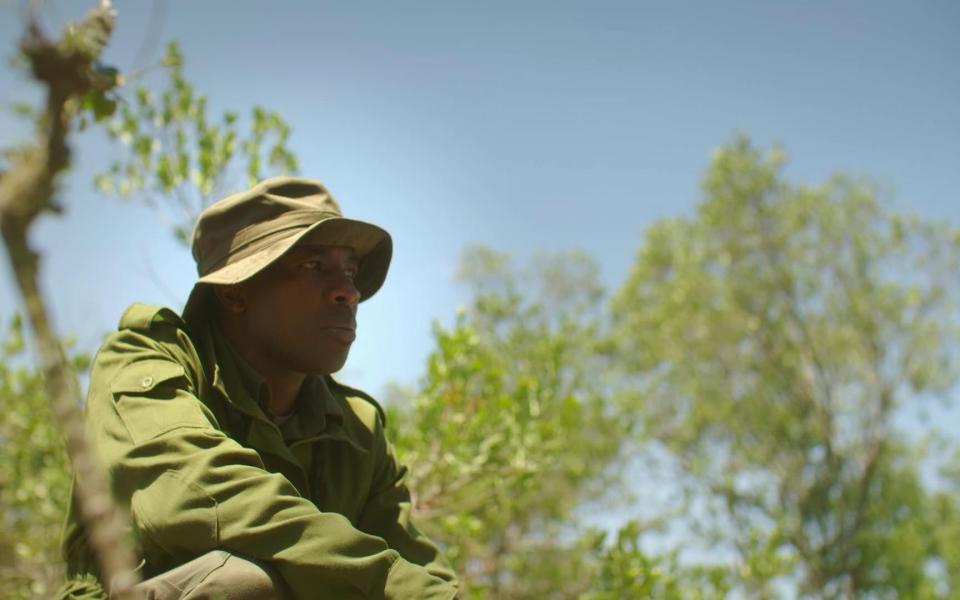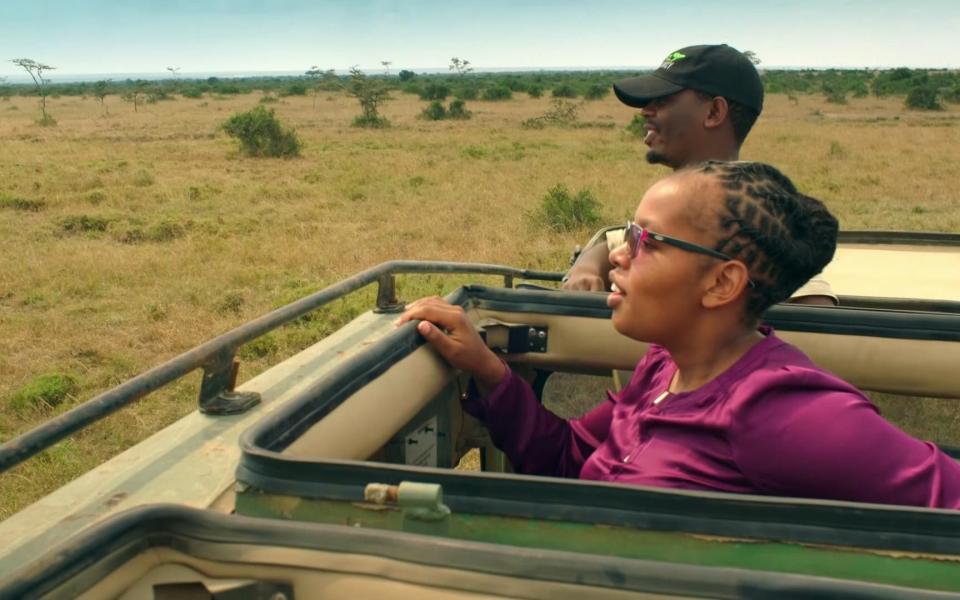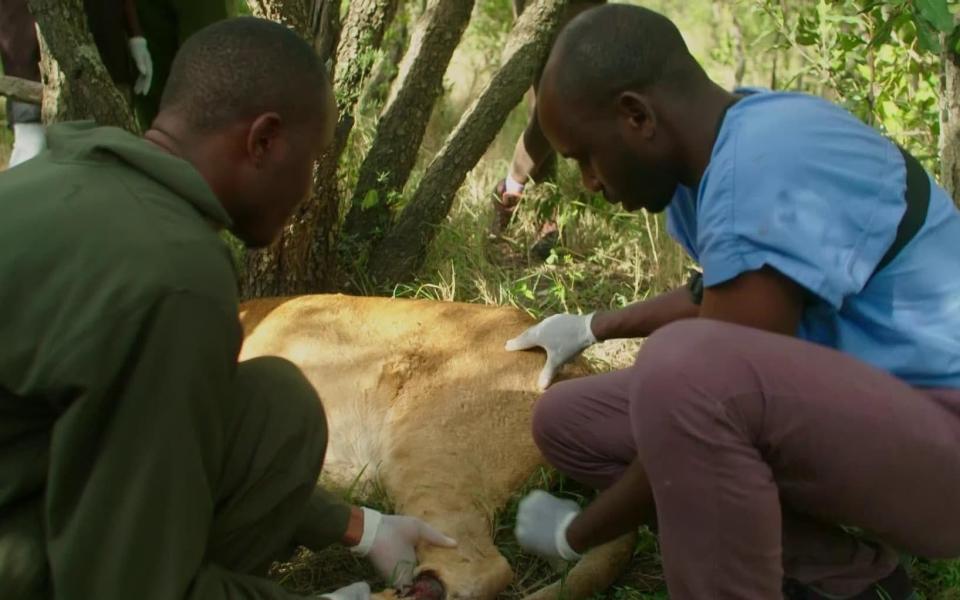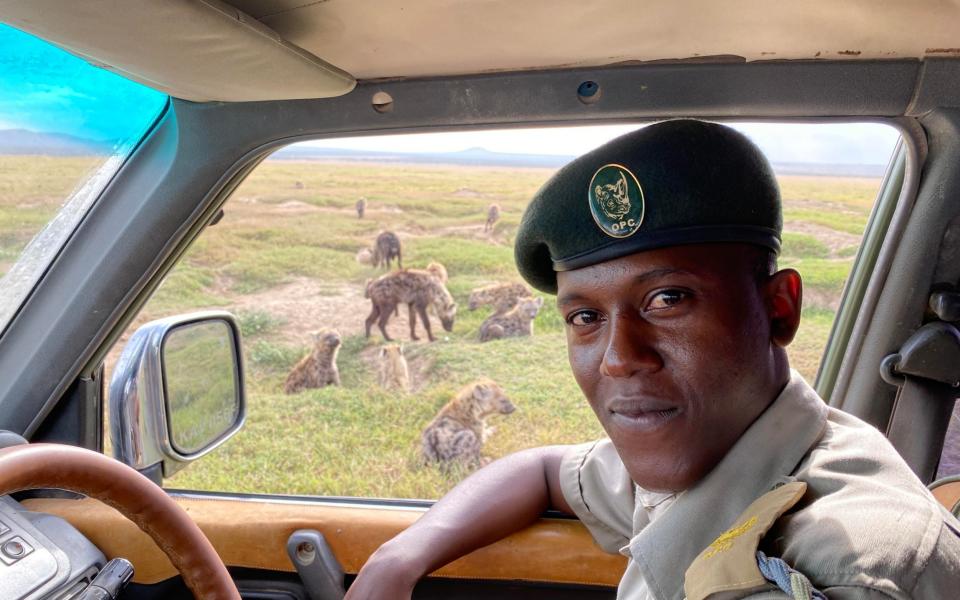‘I’ve seen a rhino shed tears’ – Kenya's animals through the eyes of its rangers

It’s hard to believe a rhino can feel anything through its thick, leathery armour, but when caretaker Joseph Wachira gave his docile dependent a tickle, I swear the 1.5-ton animal smiled. Soft and pliable, like an underbaked pastry, the skin was like nothing I had imagined; then again, patting a wild animal whose mood can swing like a pendulum was not a scenario I had visualised either.
Raised in a zoo, Najin is a northern white rhino living in a protected enclosure at Kenya’s Ol Pejeta Conservancy. Endangered even by rhino standards, she is one of the last two animals of her kind, protected and looked after (along with other vulnerable species) by a dedicated team of rangers, vets and caretakers whose stories are told in Secret Safari: Into the Wild – a new, six-part Channel 4 documentary that begins on Tuesday.
The conservancy, set in the shadows of Mount Kenya on the Laikipia Plateau, is best known for being the home of Sudan, the last male northern white rhino. Affable but sexually ineffective, he would eventually succumb to injuries sustained from a previous life in captivity, without producing an heir.
His death in 2018 was a chilling wake-up call, typifying the brutal reality of extinction so many of our world’s species face. But, as I learned on my tour of the rhino enclosure, a pioneering IVF programme, using Sudan’s frozen sperm and several surrogate white rhino mothers, means that all hope is not lost.
These rays of hope are constantly cast by Ol Pejeta, a sanctuary for many threatened species. A protected area the size of the Isle of Wight, it accommodates East Africa’s largest population of black rhinos, along with a plethora of charismatic predators and vulnerable herbivores. Given the often overwhelming challenges of habitat loss, wildlife conflict in communities and sophisticated poaching syndicates, it is a full-time job to manage their survival, as Secret Safari: Into the Wild shows. Its episodes document the emotions, dangers, treats and rewards of working in a conservancy that has become a blueprint for managing wilderness areas – as well as the lives of the animals themselves. There are stories of a black rhino trying to protect her newborn calf from predation; of a young ostrich learning to rear its first flock; and of an impala defending his harem of 50 females against rival suitors.
Most impressive of all, however, are the tales of staff working at Ol Pejeta. Here, some stars of the series share their experiences, detailing the thrilling highs and traumatic lows. When the time comes, you too can visit the conservancy and witness their life-affirming work first-hand.
Secret Safari: Into the Wild starts at 8pm on Tuesday on Channel 4. For more information, see: olpejetaconservancy.org/secretsafari Overseas holidays are currently subject to restrictions.
THE 24-HOUR WATCHMAN
James Mwenda, rhino caregiver
In the past three years, not a single rhino has been poached on the conservancy, a result of strict security measures and good relationships with the community. However, rhino caregiver James Mwenda admits that the dread of finding a carcass never disappears.
“Apart from the risk we face of being threatened by these wild animals on an everyday basis, the worst case is to wake up in the morning and find a rhino poached. It is something I always fear,” he admits.
Fortunately, he has watched many of the “beautiful and charismatic” rhinos grow to maturity, and has spent the past seven years protecting the planet’s last two female northern white rhinos, Fatu and Najin, feeding them daily and monitoring their health. He describes them as being “just like big dogs” but warns that wild black rhinos aren’t quite so accommodating. “They are very aggressive,” says James, who has been charged by rhinos on several occasions, “but it’s like being a driver on the freeway. You get a puncture, fix it and go on!”

One of the greatest and most emotional periods of his career involved four and a half years of caring for the last male northern white rhino, Sudan, who he describes as being “the face of extinction”. “I used to call him buddy,” he recalls fondly. “At some point in 2015, I was feeding him, and I saw him dropping tears. That really stuck with me. Extinction is this dark, infinite road that was calling him on the other side. I remember standing up and laying my hands on him and telling him everything is going to be fine.”
Seeing the pain endured by Sudan gave James the inspiration to be “a voice” for the species. But, along with the sadness, he insists that he has plenty of fond memories too. “Sudan was really good at passing wind,” he laughs.
THE ECOLOGY HOUSEKEEPER
Mercy Waithira, wildlife and ecology officer
Although most of her work focuses on a plan to create a 20,000-acre extension zone for an overspill of black rhinos, Mercy Waithira confesses her true love is birds. For the documentary, a film crew shadowed her attempts to help Masasai ostriches Cedric and Koki successfully hatch a clutch of eggs.
“Populations have been declining for some time,” she laments, “mainly because the unborn chicks are vulnerable to predators.”
In the programme, Cedric and Koki’s clutch falls victim to a clan of hyenas, leading Mercy and her team to offer a helping hand. “Intervention is a last resort,” insists the conservationist, who led efforts to sedate and capture the birds, placing them in a predator-free boma to breed, “but it’s necessary in a situation like this when the numbers are too low.”

Making the decision to step in might have been easy, but catching the super sprinters was another matter. “Chasing a big bird is quite hilarious,” giggles Mercy. “You can’t outrun them. It took us several days.” Fortunately, the team’s efforts paid off, with seven new arrivals of a bird Mercy affectionately compares to dinosaurs. “Nothing about them makes sense,” she laughs.
Another bird close to her heart is the crowned crane, an endangered avian species that also has a starring role in the show. “They are beautiful – how they look, how they walk, how they dance,” says Mercy. “They are one of those things the creator must have taken good time to work on.”
But, aside from protecting birds, Mercy says the greatest reward of her job is simply marvelling at the resilience of nature. “When we started working on the rhino extension zone, I never thought we would be able to do it,” she confesses. “But watching the land spring back was like zero to 100. Every time you restore an area, the species will return.”
THE ANIMAL DOCTOR
Dr Stephen Ngulu, wildlife veterinarian
Working as a resident vet carries considerable prestige for Stephen Ngulu, who monitors Ol Pejeta’s animals and assists with wildlife management. But he also shoulders a burden of responsibility.
“It is very painful when you have been treating an animal for some time and it doesn’t make it,” he sighs. “Sometimes you ask yourself, ‘Why could I not save them’?”
In the series, Stephen faced a difficult moment when treating sick lion Sekela, who has been injured. “Initially, I had made the decision to euthanise her,” he recalls, “but after consultation with a senior colleague, we decided to give her a second chance. Because lions are very resilient animals, she came out of it alive.”

Those episodes of elation spur Stephen to continue doing a job he loves and regards as vital, but he admits there are times when his own life has been in danger. Darting elephants is one of the most challenging tasks.
Captured on film, Stephen was called to remove the afterbirth still hanging from a female. “The difficulty was dealing with her one-week-old baby, who wouldn’t go anywhere,” he says. “In the end we drove them both into a herd of elephants, who took care of the calf.”
Timing is crucial when dealing with animals such as elephants and rhinos. “The most critical thing is to be prepared,” he explains.
Unfortunately, things can go wrong – such as the occasion when a dart didn’t discharge properly, leaving a baby sedated but the angry mother fully awake. “Two females were trying to overrun our car and rangers were shooting continuously in the air,” he explains. “We had three minutes to work on the animals; it felt like three days.”
The highs, however, far outweigh the lows. “It is a fulfilling job; you get tangible results,” enthuses Stephen.
THE CREATURE COMFORTER
Abraham Njenga, wildlife administrator
When you work alongside animals for such a long time, they become like members of your family, says Abraham Njenga, who is involved in overseeing every aspect of rhino care and rehabilitation. Those emotions make it hard to accept some of nature’s cruel realities, demonstrated by the story of Lola and her calf in the series.
Born in a boma and released back into the wild, Lola still recognises Abraham’s voice. “When I call her name, she comes up to say hi and then goes away again,” he says, fondly. During filming, however, her young calf was killed by a lion.
“We develop a real connection with these animals, so we feel bad when something like that happens,” admits Abraham. “For me, I see these animals as my kids; I care for them in the same way. When you release them back into the wild, it’s like sending them to school on the first day. You’d prefer them to stay at home, but you know they have to go.”

Although working with Ol Pejeta’s four-legged residents is an emotional rollercoaster, Abraham says the toughest part of his job involves dealing with people. Whenever problem animals have strayed into surrounding communities, the team must intervene and push them back into the conservation area.
“I remember a time we were called to assist with elephants,” he recalls. “Everyone turned up to make noise and throw stones at the animals. It was very hard to control.”
Mitigating community and wildlife conflict is, however, an important part of his job. Besides, any frustrations quickly evaporate the moment he receives news of a newborn rhino calf.
“That make me truly excited,” he says. “It gives me great satisfaction to know we are making big strides when it comes to conservation.”
The details
Abercrombie & Kent (01242 547760; abercrombie kent.co.uk) is offering a five-night stay at Ol Pejeta Bush Camp from £3,699 per person, based on two people sharing. The price includes international flights with Ethiopian Airlines, transfers and full-board accommodation. Includes £50 per person contribution towards a Covid-19 test and comes under A&K’s flexible booking policy


